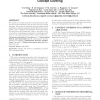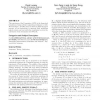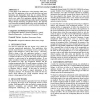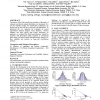WWW
2005
ACM
15 years 5 days ago
2005
ACM
In this paper we present the Infocious Web search engine [23]. Our goal in creating Infocious is to improve the way people find information on the Web by resolving ambiguities pre...
WWW
2005
ACM
15 years 5 days ago
2005
ACM
We exploit the recently proposed Concept Abduction inference service in Description Logics to solve Concept Covering problems. We propose a framework and polynomial greedy algorit...
WWW
2005
ACM
15 years 5 days ago
2005
ACM
This work aims to provide a page segmentation algorithm which uses both visual and content information to extract the semantic structure of a web page. The visual information is u...
WWW
2005
ACM
15 years 5 days ago
2005
ACM
In the paper, we present an approach to mining a directed social network from a message board on the Internet where vertices denote individuals and directed links denote the flow ...
WWW
2005
ACM
15 years 5 days ago
2005
ACM
It has been a few years since the semantic Web was initiated by W3C, but its status has not been quantitatively measured. It is crucial to understand the status at this early stag...
WWW
2005
ACM
15 years 5 days ago
2005
ACM
The correctness of the Z semantics of OWL is the theoretical foundation of using software engineering techniques to verify Web ontologies. As OWL and Z are based on different logi...
WWW
2005
ACM
15 years 5 days ago
2005
ACM
Finding all the occurrences of a twig pattern in an XML database is a core operation for efficient evaluation of XML queries. A number of algorithms have been proposed to process ...
WWW
2005
ACM
15 years 5 days ago
2005
ACM
A major factor in the effectiveness of the interaction which users have with Web applications is the ease with which they can locate information and functionality which they are s...
WWW
2005
ACM
15 years 5 days ago
2005
ACM
Term weighting scheme, which has been used to convert the documents as vectors in the term space, is a vital step in automatic text categorization. In this paper, we conducted com...
WWW
2005
ACM
15 years 5 days ago
2005
ACM
Taxonomies of the Web typically have hundreds of thousands of categories and skewed category distribution over documents. It is not clear whether existing text classification tech...




